How to Out-market Cyber Schools
Battle-tested school marketing strategies for brick-and-mortar school leaders

The private sector holds ideas and strategies that have been battle-tested for decades. With experience building brands and engaging audiences, professional marketers have developed ways to improve any marketing initiative. Private sector strategies are geared towards selling goods and services that will make a profit. However, an education is not a consumer product; it’s an experience, a public good.
The marketing of cyber schools, especially that of K12 Inc. and Connections Academy, offers unique insights into marketing an educational experience. They have seasoned digital marketing teams spending millions of dollars to attract students, and they are directly competing with public school leaders.
To show you how they do it, we’ve conducted a variety of studies to understand their playbook, with insights into their best ideas. Whether or not you're competing for students, there's something to be learned from the strategies employed by cyber management companies.
Click on any section to jump right to it.
- Audience: targeting focused groups
- Messaging: emphasizing strengths, anticipating objections
- Communication: staying consistent across channels
- Conversions: simplifying action steps
Audience: targeting focused groups
The first step to marketing is choosing the specific audiences that will best help you meet your marketing goals. K12 Inc. and Connections Academy are casting a wide net, then using targeted sales and marketing to reel in the families who are most likely to enroll. By analyzing data from both companies’ marketing spends, as well as the structure and placement of their advertisements, we can see how they are tailoring their messaging to particular groups.

Our Research Methods
K12 and Connections target families who are researching school options on Google. Google allows advertisers to serve their ads on specific terms that they expect their audiences will search. You have probably seen these ads in the top few results with the word "ad" marked next to them. The terms, chosen by advertisers, are called keywords. For example, a company advertising apples might want their advertisement to show up when someone searches “Gala” or “Granny Smiths.”
Search engines want to show people the content they are looking for. If Google thinks your ad is relevant to the search, then your ad will show up higher on the page. The more traffic you get on your ad — or the more times people click on it — the more relevant they will deem an advertisement.
We analyzed three data categories using a tool called SpyFu, a program that searches millions of terms a day to discover which ads appear.
Keywords: Analyzing the keywords the companies choose gave us insights into which audiences they target. For example, if they chose the keyword “homeschool,” it suggests that they are targeting homeschool families.
Ad Ranking/Relevancy: Analyzing how high their ads are ranked on each of these terms—or how relevant Google is deeming the advertisement—shows us how effectively these EMOs are targeting their audience.
Traffic: Analyzing which keywords are garnering the most ad traffic shows us who is interested in Connections and K12's ads.
Homeschool students
At its start, K12 primarily targeted homeschool families. Their offer—an accredited teacher, free curriculum, and extra support—speaks directly to these families’ needs. In some rural areas, cyber companies even give their customers free internet and laptops, which can be life-changing assets for low-income families.
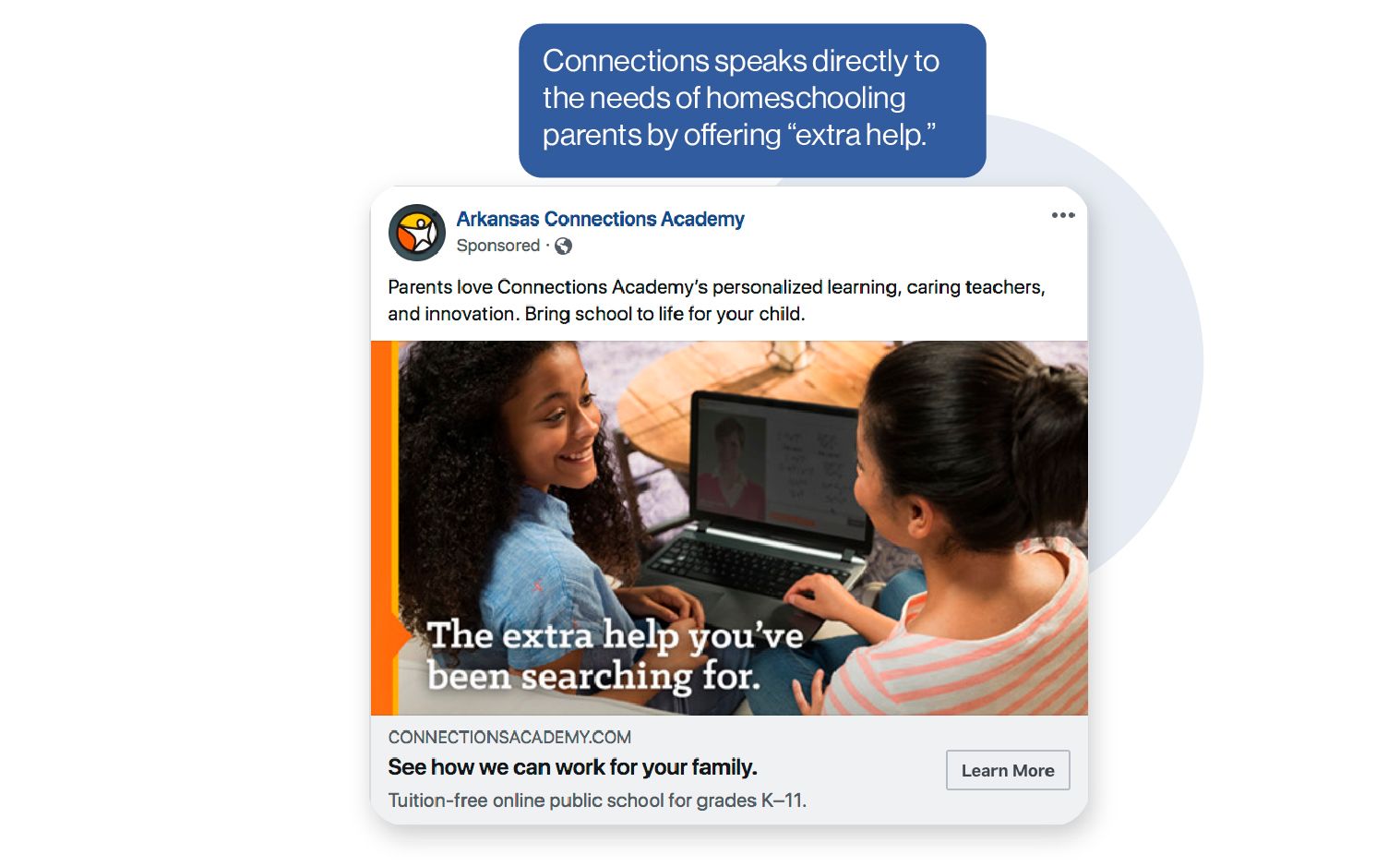
K12’s ads garner the most traffic on the search term “best homeschooling programs,” meaning that the company likely pays a high price to target their ads to families searching that term. Judging by the sheer amount of traffic these ads are getting—over 25,000 clicks since 2015—that investment is paying off. Connections is also targeting terms related to homeschooling, and getting even more attention: around 112,000 clicks.
And even without any data analysis, it's clear that both K12 and Connections care about this specific audience. Both companies dedicate a section on their website to providing information to homeschool families. A peek at Connections’ homeschool page shows they understand the struggles homeschool parents face, and are positioning themselves as the solution to those struggles. “Deciding to homeschool your child is a big commitment,” it says. “What if you could have the benefits and personal involvement of homeschooling without bearing all of the responsibility yourself?”
Highly mobile families
Transferring schools can be hard on students, and cyber schools have clued into this concern. Both K12 and Connections target parents who are serving in the military, working as truck drivers, or who are similarly prone to moving around.
Military families are of a particular focus; one section of K12’s website centers specifically on these families. Elsewhere, the site’s “day-in-the-life” section tells the story of Mari, a K12 student whose father is in the military. All over their site and advertising, they’re hammering their targeted message home: “With K12, learning can take place wherever you are.” As they describe their curriculum, they bold the word “consistent.”
Students with illness or disability
Online schools fill a hole in the market for students who can’t attend traditional schools due to disability or chronic illness. They also serve as a safe haven for students who have been bullied or struggle with anxiety.
This audience group is especially highlighted in companies' online presence. Connections has a “student spotlight” section of the website, which tells the success stories of several students with disabilities, like Evan, a middle school student who uses a wheelchair and ventilator. K12 reposts blogs and news stories of students writing about their experiences in online school after being bullied in a brick-and-mortar school. One student wrote that online school "was truly the best thing that ever happened to me." When these stories come from students themselves, their impact becomes more powerful.
Students behind on graduation requirements
To students struggling to graduate in brick-and-mortar schools, online schooling can be seen as a more attainable option. This category ranges from students who were incarcerated to students who failed one or two classes.
Connections and K12 ads are favored by Google, meaning that they are relevant, for words associated with graduation. When families search “how many credits to graduate” or “high school diploma online free,” Connections' ads are favored on Google in almost 3,000 combined searches. Similarly, K12 ranks for keywords like “online high school courses” (6,000 searches), “credit recovery high school" (2,800 searches), and “high school credit recovery” (2,500 searches).
Cyber schools also target this audience group on their websites. Connections has a resource section built for teens, complete with "Helpful Tips and Info for Talking to Your Family" about the benefits of online school. They've made content that targets students, rather than parents, ensuring that their target demographic gets in the door.
Gifted students
Online programs’ flexibility allows gifted students to schedule their day around extracurricular training—or to work ahead if needed. Both companies share news stories and blog posts of students utilizing the flexibility of online schools to train for the Olympics or start their own business. These stories are often picked up by local news stations.
Connections features Taylor, a competitive horseback rider, and Lydia and Logan, twin sisters whose rigorous dance schedule requires them to work at home. Needless to say, gifted students' stories are popular in cyber schools' promotional material.
This flexibility is also angled toward accelerated students. Connections regularly posts news stories about students who graduate years early from their program. Matthew Hartzell, an alumnus of a virtual school powered by K12, wrote about his experience jumping ahead several grade levels using the EMO's program. Hartzell's story is featured front and center on the "Student Success" section of K12's website.
Similarly, both companies use ads to market their academic flexibility for gifted students. One television ad says, “Does your child need a more challenging education?” Another ad features a K12 student talking about her experience with online school, “When I want to finish five lessons in one day, I can do it,” she says. Their messaging not only attracts exceptional students, it also gives the program more credibility as an educational institution.
Takeaways
Cyber schools spend extra time on the front end identifying who needs their product. They then create messaging that specifically targets those particular audiences.
- Identify which audiences are most likely to respond well to your campaign.
- Figure out their needs and interests.
- Explain how your district uniquely meets your audience’s needs.
Messaging: emphasizing strengths, anticipating objections
Your messaging should explain how your product addresses your audience’s deepest needs. Cyber schools build messaging that emphasizes their strengths and combats their weaknesses. The three most common messages in their marketing are: :"Tuition-free", "accredited", and "personalized".
"Tuition-free" and "personalized" both highlight qualities in their program that are most attractive to their audience: families looking for free academic support and accommodations for their students' unique needs. Both companies also use their messaging to combat their bad academic reputation, focusing on the fact that the teachers and curriculum are fully accredited.
Our Research Methods
We wanted to know what these companies are saying. To do so, we ran a text analysis (n-gram analysis) on all of their Google advertisements, on unique ads running on their Facebook pages near the 2018-2019 fall enrollment deadline, and on 16 of their TV spots. This analysis shows us which words and phrases were used most frequently in these advertisements, as well as how often each word or phrase was used. These numbers give us an idea of which messages K12 and Connections prioritize and highlight most pervasively.
Getting the text:
We used SpyFu’s analysis on K12’s and Connections Academy’s Google advertisements to procure the text from each of their Google ads—nearly 10,000 of them from 2015 to 2018. Facebook makes ads available to anyone if they click “info and ads” on their Facebook page. Finally, we transcribed eight television commercials each from K12 and Connections Academy.
Repetition
All across their communication channels, K12 and Connections share the same messages: tuition-free, accredited, and personalized. Their messaging stays consistent on their website, commercials, and social media advertisements.
Though their messaging has a consistent throughline, the content in their ads is varied. They tell student stories, show experiences like volleyball and robotics, and highlight teachers, using similar wording to describe each experience. The following ads ran in spring of 2018. Ads like these are served to targeted audiences in hundreds of specific locations around the country.
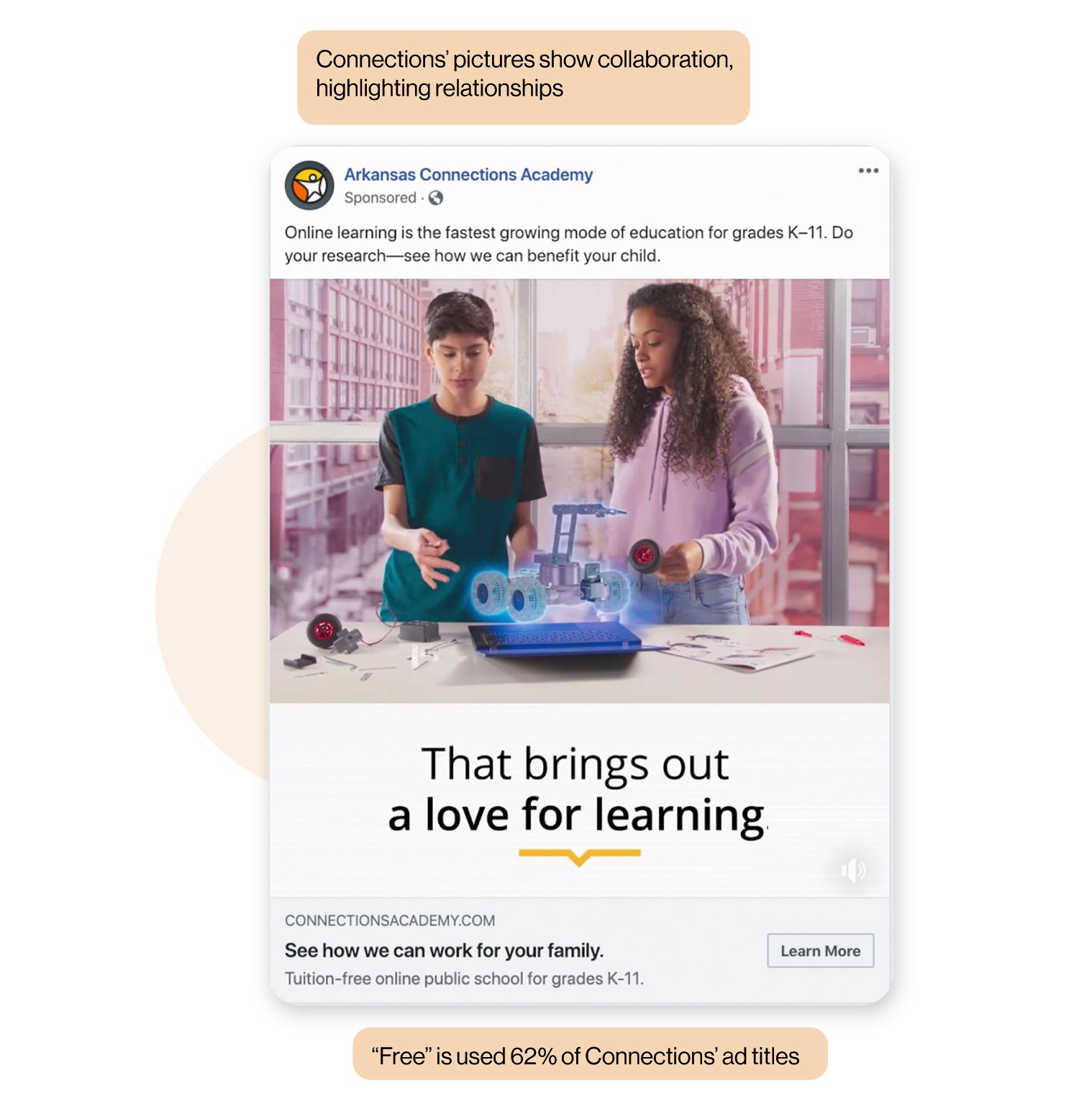
Tuition-free
Alternatives to public education, like tutors or private academies, are out of budget for many American families. To respond to this challenge, both schools consistently reinforce that they are "tuition-free."
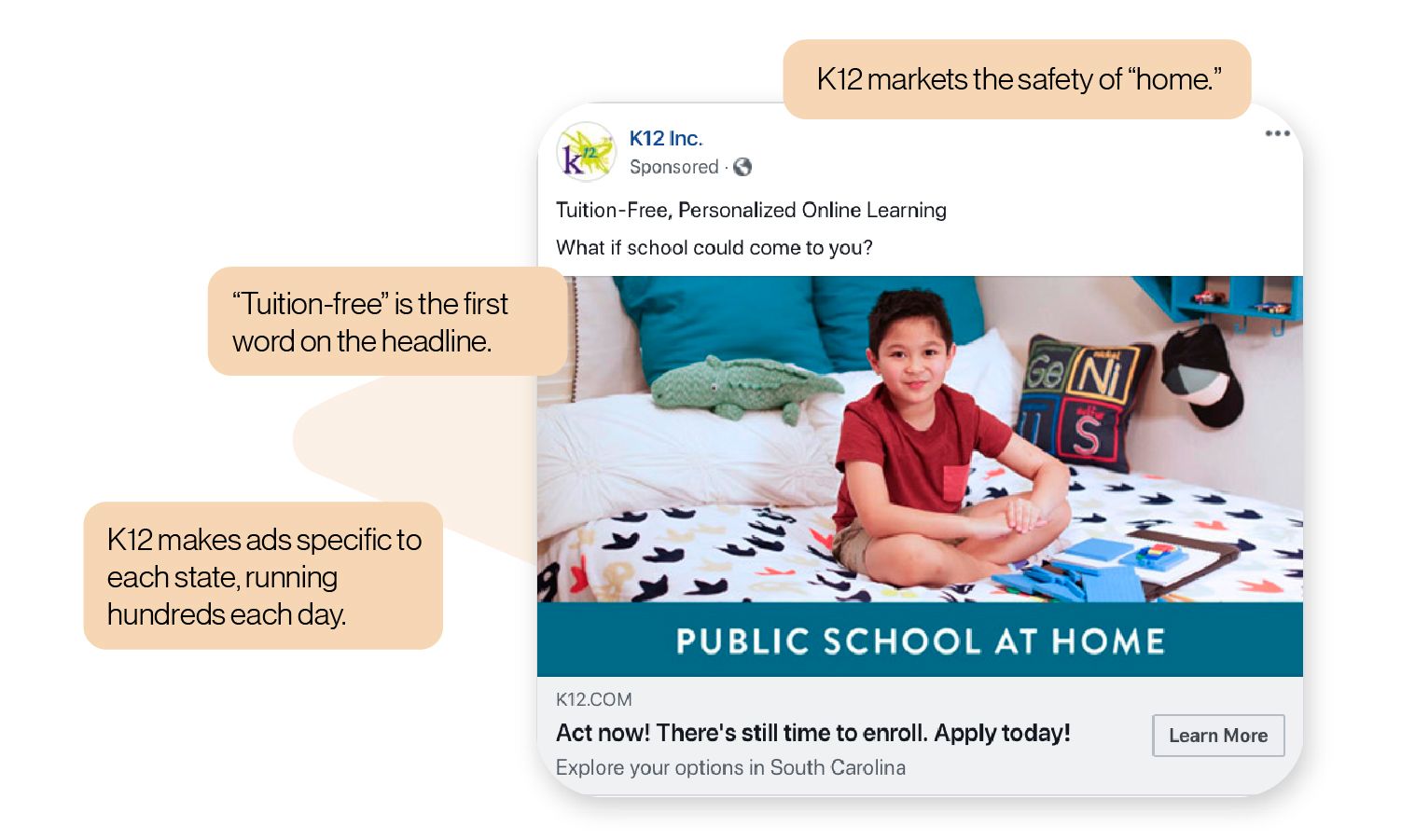
The phrase “tuition-free" appears on the banner of Connections Academy’s homepage—and smack-dab in the middle of K12’s. According to our analysis, the word “free” appears in 62% of Connection Academy’s ads. “Tuition-free” is the fifth most common word in K12's ad copy, showing up in about 19% of their ads.
Why such an emphasis on this point? When you consider the needs of homeschool families—a curriculum supplement or extra support—this strategy makes sense. A free online option gives some low-income families more control over their child’s education without the cost of private school. It's telling that the next three most common words in K12's ads are "homeschooling," "home," and "homeschool."
Accredited
Both K12 and Connections utilize targeted messaging that counteracts parents' worries about their programs' effectiveness. Words that build trust, like "official" (used in 1,020 ads), "quality" (477 ads), and "accredited" (476 ads) all appear in the top 20 most frequently used words in K12's ad titles. In the "How Learning Works" section of K12's site, they describe their program as a "high-quality, personalized education experience."
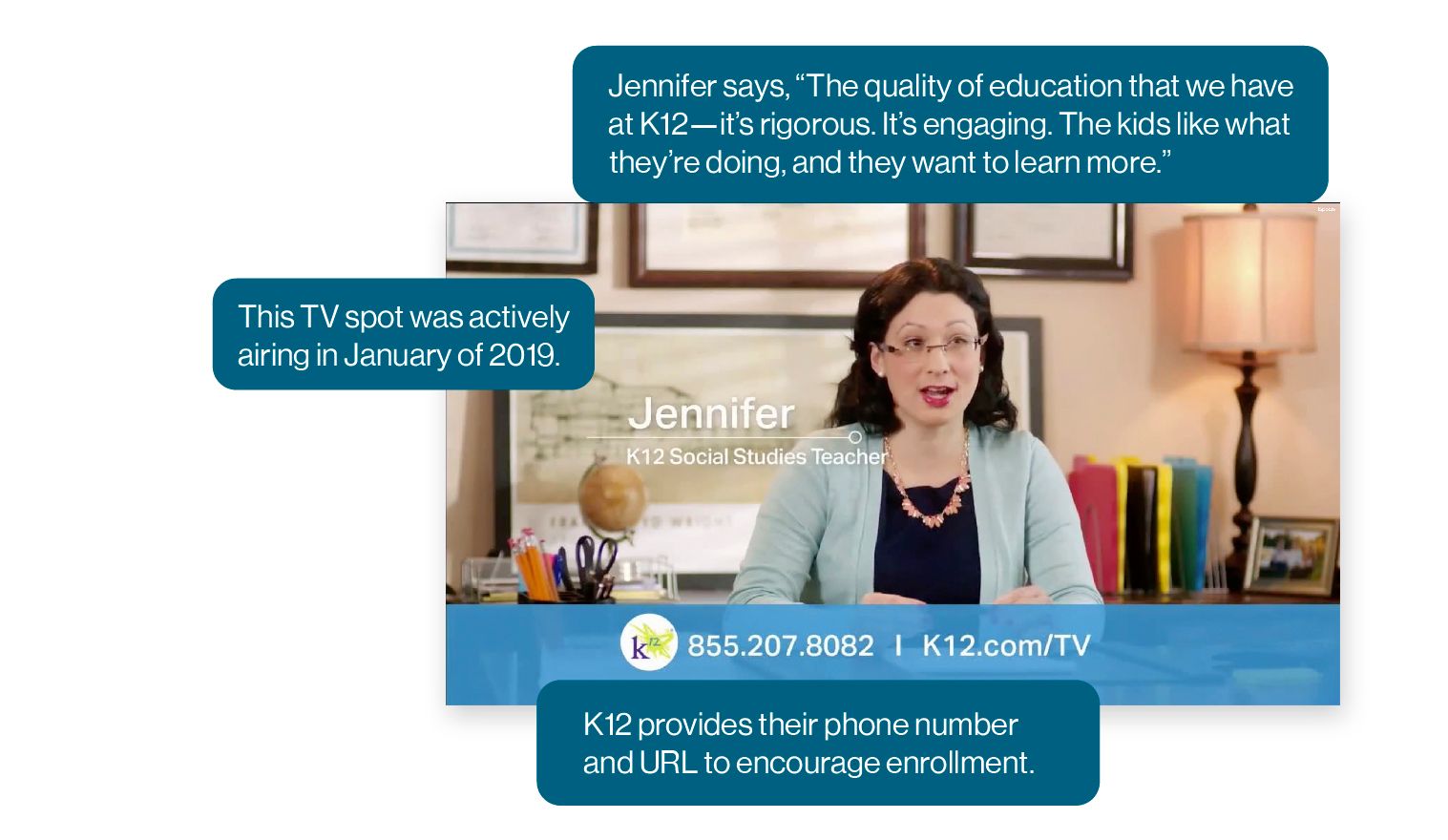
Though the average student-teacher ratio for cyber schools is 44-to-1 (see Report: The State of Cyber Schools), both K12 and Connections heavily feature teachers in their marketing. In our analysis of both companies' TV spots, we found that the word "teachers" appeared in 88% of the ads. Additionally, "curriculum" showed up in every single K12 commercial and in half of the Connections spots we analyzed. Unsurprisingly, any message about teachers ties into a conversation about qualifications. On the "Meet Our Online Teachers" page of K12's website, they tout their instructors as "fully qualified to teach online."
Even if they're not actually providing quality educational experiences, K12 and Connections aren't dummies. They know what their target audiences might have heard about their programs, and they're deploying marketing to counteract those negative perceptions.
Personalized
The message of personalization powers K12 and Connections' most impactful, story-driven content. In every school, parents want programs that meet their students' individual needs. Through their marketing, these companies claim to offer just such programs.
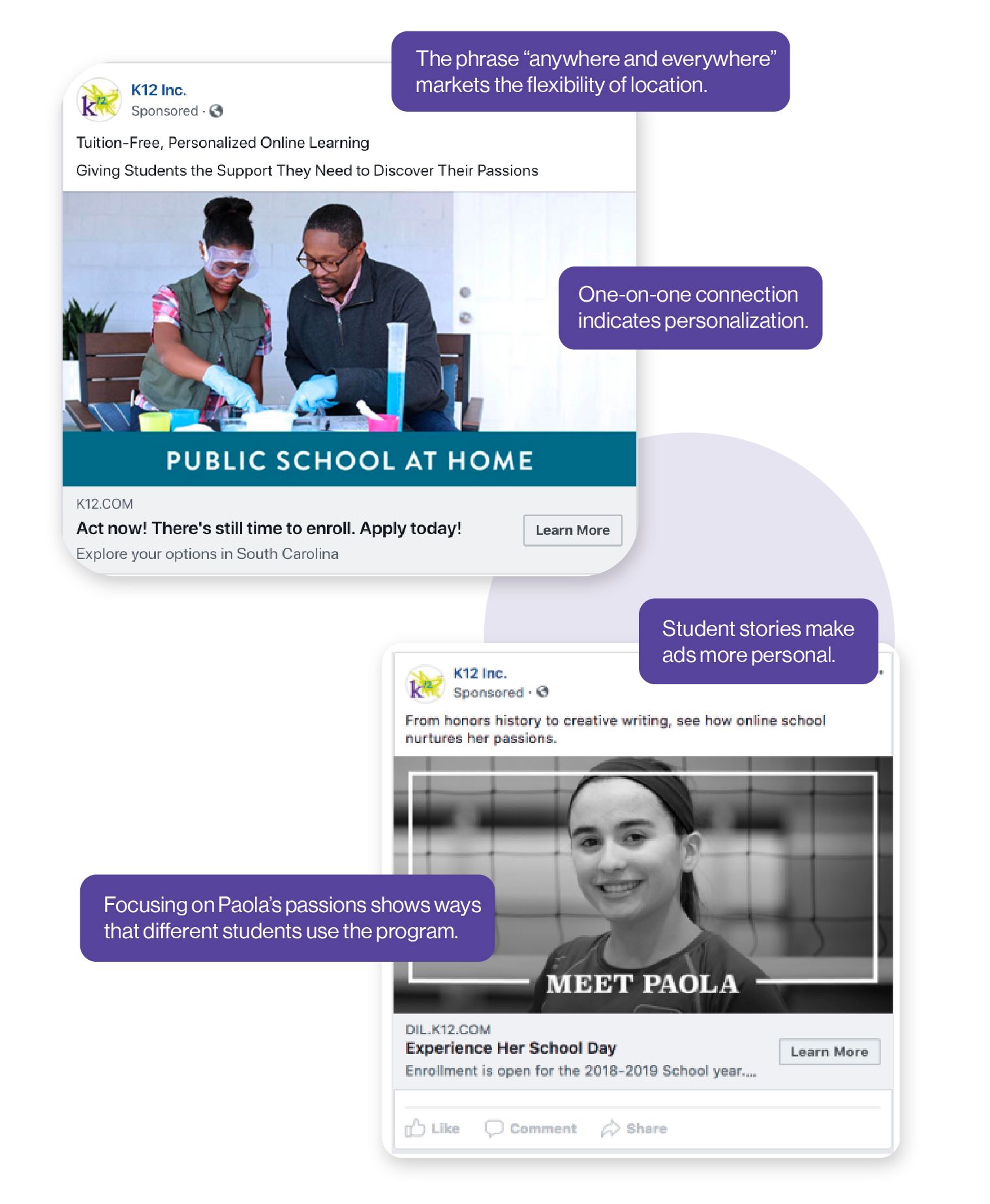
In 50% of their Facebook ads, K12 used the word "personalized"; and in 25%, the word "passions." Connections also emphasized personalization in 30% of their ads. Both companies market students' ability to work from home, learn at their own pace, and explore their interests—all factors attractive to a number of their target groups, from gifted students to those with disabilities.
"Whether your student is curious, inventive, passionate, analytical, or anything in between," says one ad, "the K12 program makes the most of each child's unique brilliance."
Both programs fail to specify exactly how they personalize their curriculum or learning experiences—probably because these programs aren't actually very personalized. They divert minds away from that question by highlighting success stories: students starting their own businesses, joining the Olympics, or competing in chess tournaments.
Takeaways
Great messaging is simple, clear, and built for a specific audience. Each message either highlights a strength or counteracts a negative perception.
- Identify how your program meets your audience's needs.
- Create simple messaging.
- Repeat your message everywhere you can.
- Use student stories to support and reinforce your messaging.
Communication: staying consistent across channels
Website
K12 understands that their public-facing website is a marketing tool. The site is built for prospective students, not current ones. The company doesn't waste any space in their design, spelling out their main arguments in the organization of the website.
To grab prospective families, they strategically place their vision on their website’s main banner. “We all have one common belief that every child is uniquely brilliant and deserves a high-quality, personalized education," they claim. Parents already see the unique brilliance in their own children, a fact K12 capitalizes on. They create a vision that's easy to buy into.
The company organizes the rest of the website around their messages. The first two sections of the site tackle the issue of quality, showcasing awards, student success stories, and a sample of their curriculum. If an argument has been made against K12, a page on their website exists to contradict that argument. Take the issues of personalization and teacher engagement, or lack thereof. K12’s video profiles of teachers refocus the conversation. Set to upbeat music, they show a teacher’s organized office, explaining how she makes a special effort to reach out to students and parents.
Stories are hard to argue against, and so K12 has made a point to share as many stories of students and teachers as possible. They even hold video contests where students can upload themselves singing or sharing a poem. In one video, Katerina sings “Katusha,” a traditional Russian folk song, wearing a princess costume in her room. Tymberlyn, a Junior All-Around Clogger, freestyle clogs in front of her fireplace. By showcasing these videos, K12 is letting students do the marketing work for them. They lend credibility to the idea that the company values individuality and personalization—while skirting around the actual question of how they personalize their programs.
K12 also focuses on sharing the best version of their product. Another corner of the site allows you to navigate through a “day in the life” of several of their students. Prospective families put themselves into students’ shoes. On a timeline in this section, you can choose a time, then see what the student typically does at that hour. Again, enrollment is the main push. After you watch Zachary speed skate with his friends after history class, or Elayna post about her online puppy club, you're encouraged to “find a school,” “enroll now,” or “speak to an agent.”
Social Media Advertisements
Almost every K12 and Connections ad includes photos of students; K12 often shares student stories from the timeline feature of their website.
Each advertisement is framed around their best features. Both companies use photos to highlight the flexibility of location afforded by online schooling. In many K12 ads, students sit on their bed, on a stool in the kitchen, or in front of an interactive science project. They’re often pictured in a relatively domestic situation with a loved one—in the ads we analyzed, often a father-figure or a friend. K12 markets the comfort of home and family.
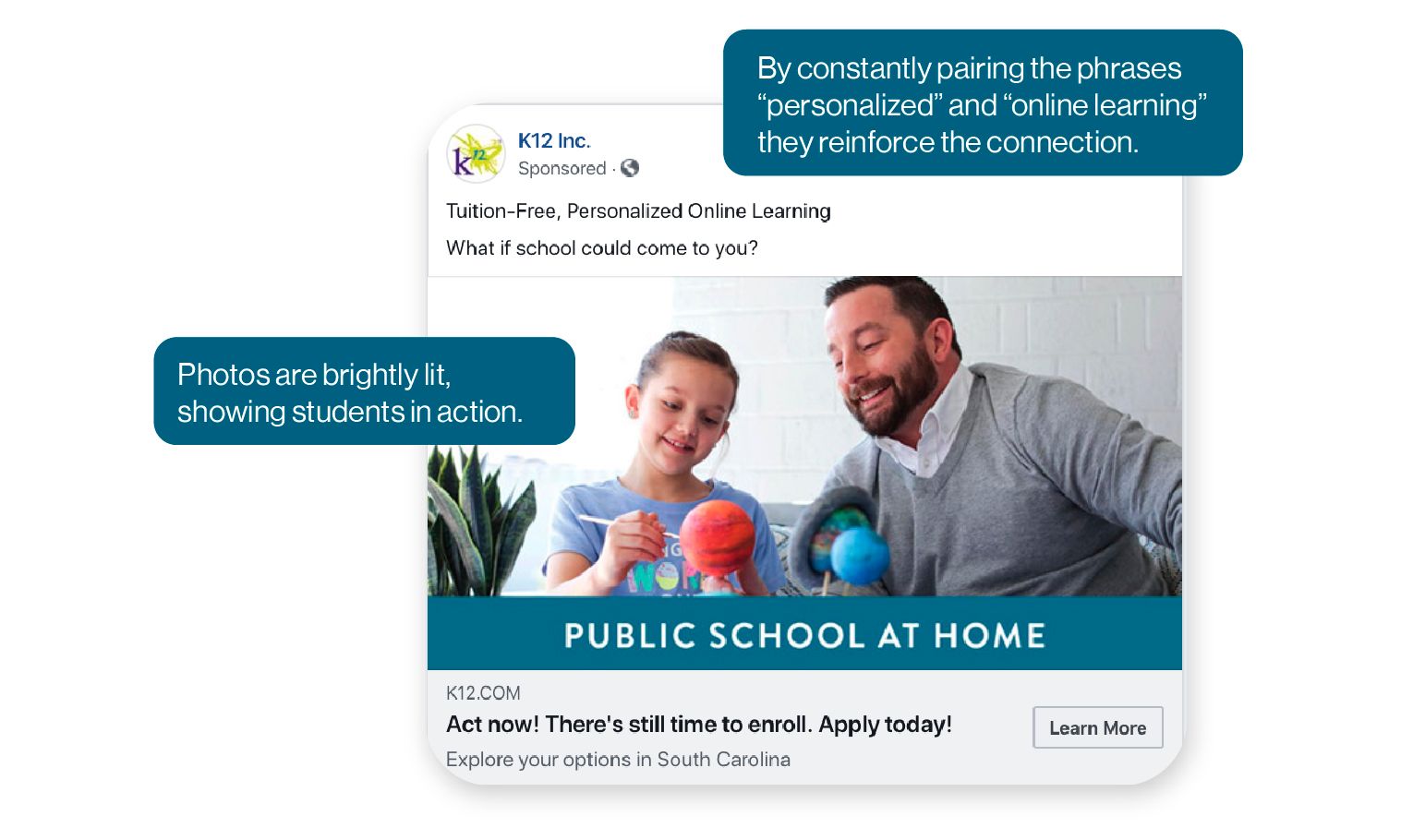
“Anywhere” is one of the top 20 most frequently used words in K12 Facebook ads, used with the tagline, “Because learning happens anywhere and everywhere.” Similarly, Connections ads try to detach online learning from the idea of a child sitting at a computer all day. They showed students outdoors, working on robotics, or visiting a science museum. If Connections students were pictured with a laptop, there was usually a hologram of the material they worked on next to them.
Similar to the website, every pixel of both companies’ Facebook ads are built to feed families through the enrollment pipeline. Most of the ads we analyzed had a “learn more” button that directs to the website, or text that encourages students to enroll for the fall. While Connections ran mostly unique ads, K12 had dozens and dozens of repeated ads, most likely targeting different subsections of Facebook users or optimizing each ad’s format.
Television and Video
Video gives marketers the opportunity to guide a viewer through an experience, showing the audience how to feel about the company while reinforcing messaging.
K12 and Connections maximize their ads' potential by sending them during critical enrollment seasons. “For the past six weeks I would say that—especially during the evening news—probably every third commercial break includes commercials from K12,” said Dr. Michael Barbour, Associate Professor of Instructional Design at Touro University California. “They do a good job on both TV and radio targeting particular audiences during particular times of the year.”
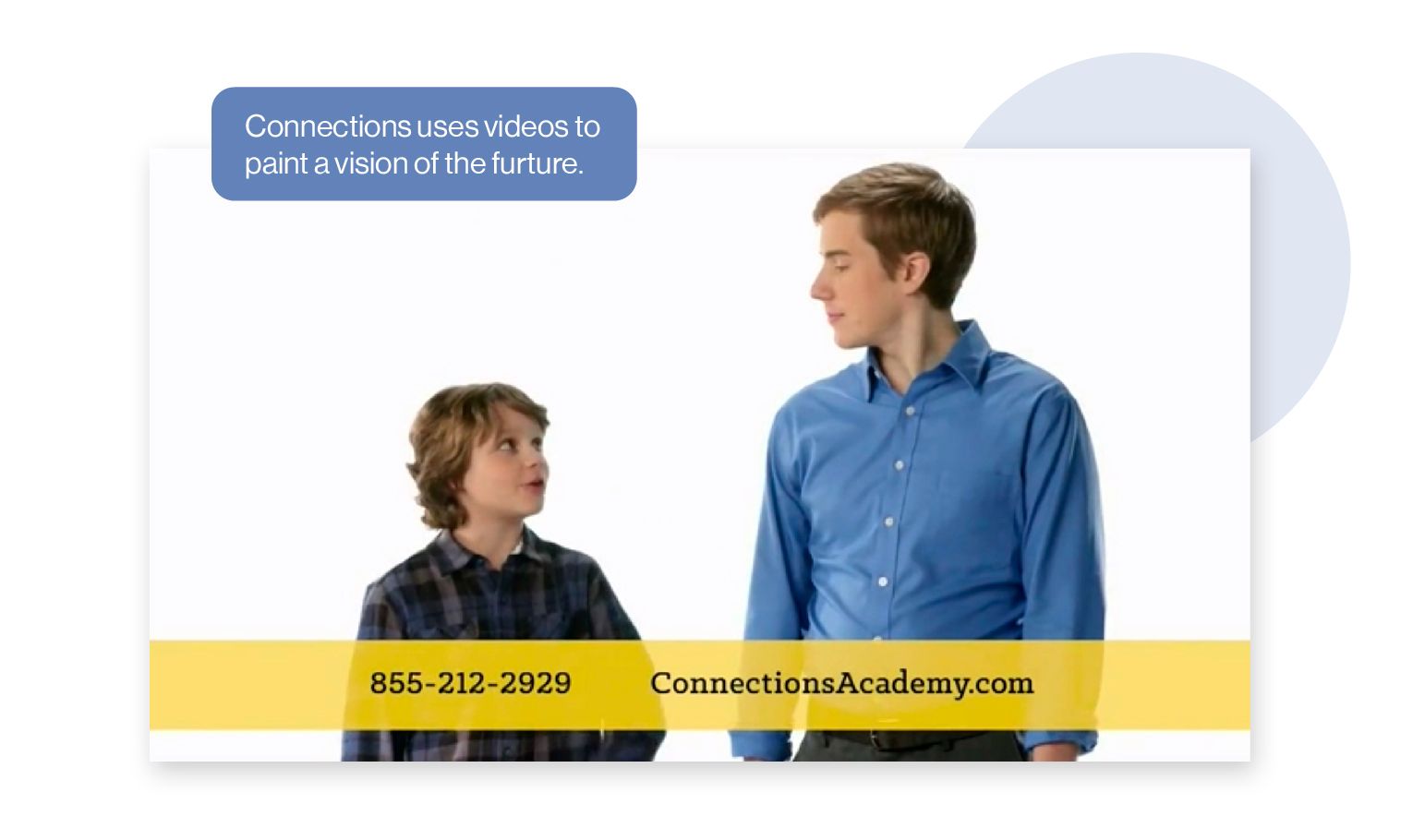
Again, both companies make sure to highlight their key messages. They mention “tuition-free, online public school” and emphasize their teachers, curriculum, and the flexibility of the program. Analyzing the text on K12 and Connections ads, we found that many commercials repeated the same phrases word-for-word. Connections often repeated: "Connections Academy is the tuition-free, online public school serving grades K-12 with caring, certified teachers; a comprehensive, high-quality curriculum; and a program that works for families like yours."
Video ads allow both companies to build their ideas in dynamic, compelling ways. A series of Connections commercials centers on the catchphrase, “Success today, success for life," featuring students—Jordan, Tyler, Ryan, and Morgan—standing next to adults that represent their future selves. They explain the moment they chose their career path—to become a chef or an architect—and the tools from Connections that helped them achieve success.
Similar to their Facebook ads, K12’s TV spots focus on students’ individuality. In a commercial titled “Uniquely Brilliant,” K12 students garden, hold up a trophy after winning an entrepreneurship competition, and test out a handmade robotic car. As uplifting music plays, the shots progress to show students’ graduation gowns, projecting the future the program promises.
True to form, each of their commercials finished with a call to action. Some of the 20 most-used words and phrases in their commercials were “connectionsacademy.com,” which appeared in 75% of the Connections ads we examined; “visitk12.com,” which appeared in 63% of the K12 ads we examined; and “call” in 75% of K12 ads we examined.
Public Relations
Leveraging local media can be an important tool for engaging the community. K12 and Connections Academy interact heavily with local media by sharing social media posts, providing relevant information to the local news, and publishing press releases. Put simply, they are present. K12 makes sure to include blog posts and notes from their CEO in posts on their website; quotes are often picked out of these posts to be shared in news articles.
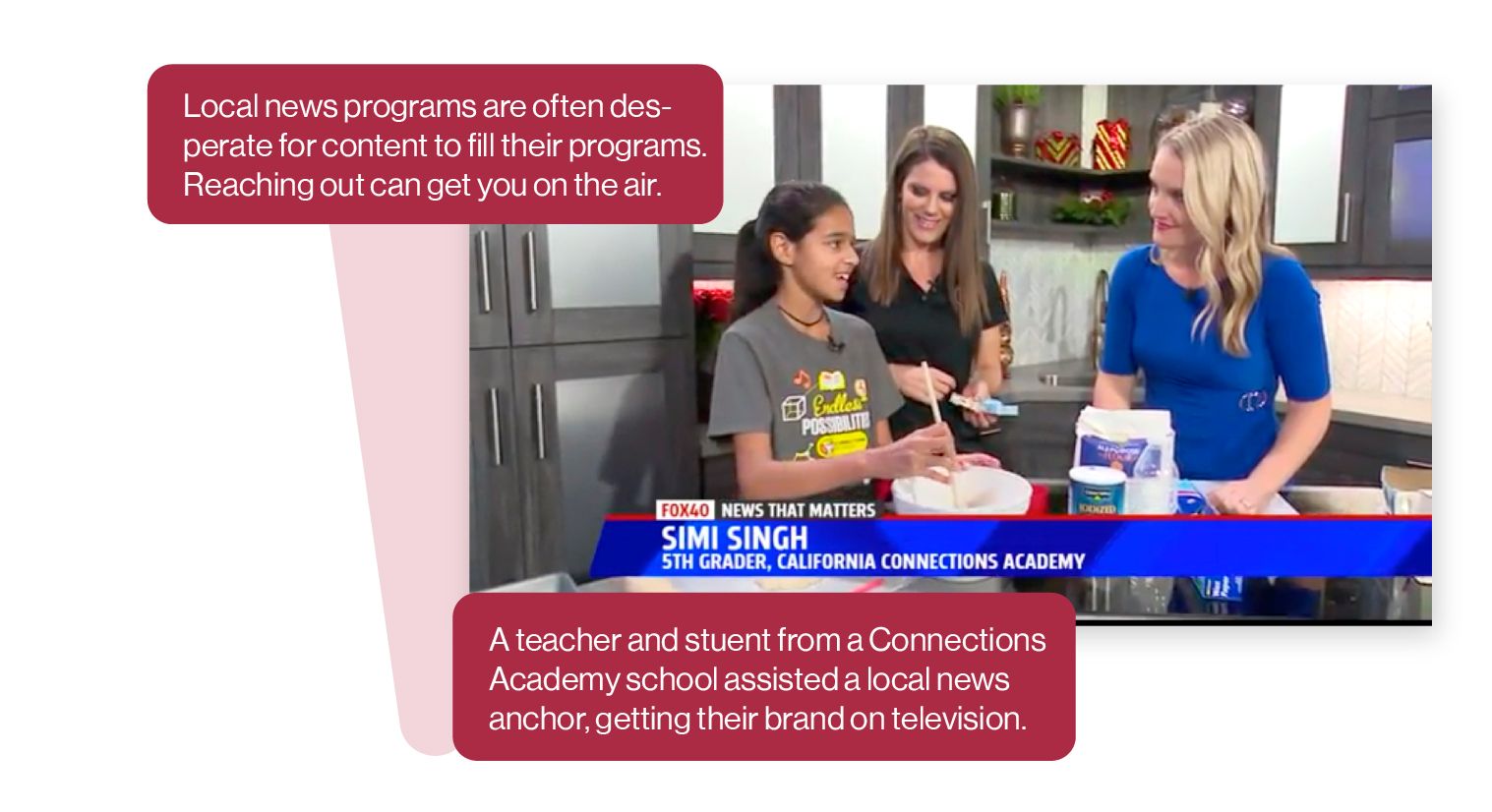
While this may seem grandiose for a small school district, the reality is that you can be present in many different ways. Even attending city forums and posting on social media puts your name into the public eye, which is part of the idea behind public relations. From the frequency with which stories of cyber students are shared in the news, we suspect that management companies are supplying stories with local news organizations preemptively. In our experience, many school leaders are quick to speak on the importance of "building a relationship with local media. When a story is shared, you want media to turn to your district for details. At the end of every blog post or press release, they include a short description of their programming, often including their contact information.
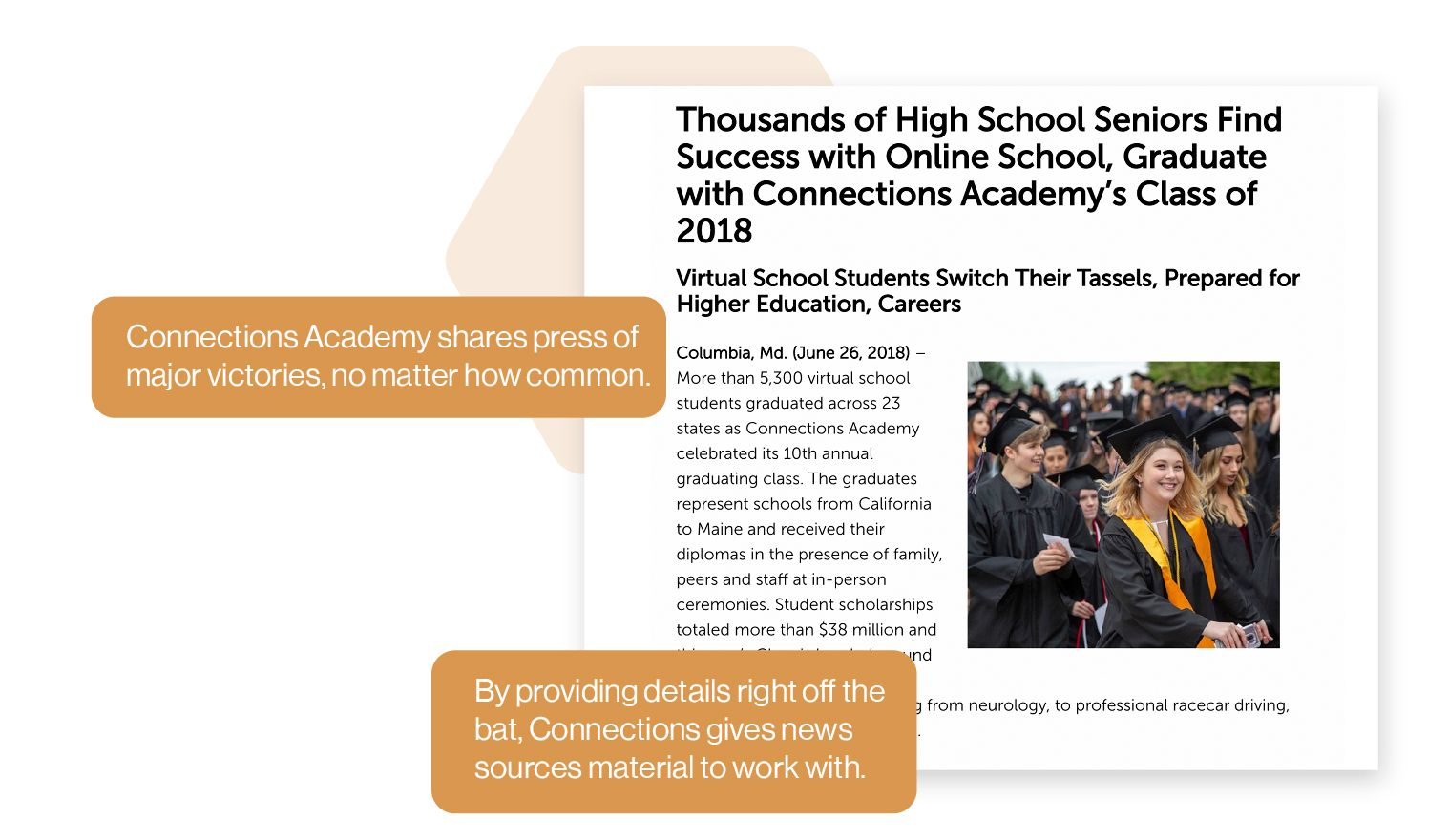
Takeaways
Both companies share their messaging across a variety of platforms, building a consistent identity by repeating their messages. They keep their messaging fresh by telling student stories that support each value.
- Cyber schools highlight their strengths and anticipate weaknesses across each communication channel.
- They repeat their messaging again and again, keeping their content fresh by focusing on student stories.
- Cyber schools constantly provide a call-to-action, encouraging their audiences to enroll.
Conversions: simplifying action steps
If you want to get married, you don't start by asking a stranger to go to Vegas—but you might start by asking them on a date. In the world of marketing, a conversion funnel is a series of simple action steps leading up to a final ask. If your audience agrees to enough "dates," they might eventually accept the sale you propose.
Marketers expect that lots of people will see their ads, a smaller set will go to their website, a fraction of those users will request more information, and only a few will “convert”—or, in the case of cyber schools, enroll.
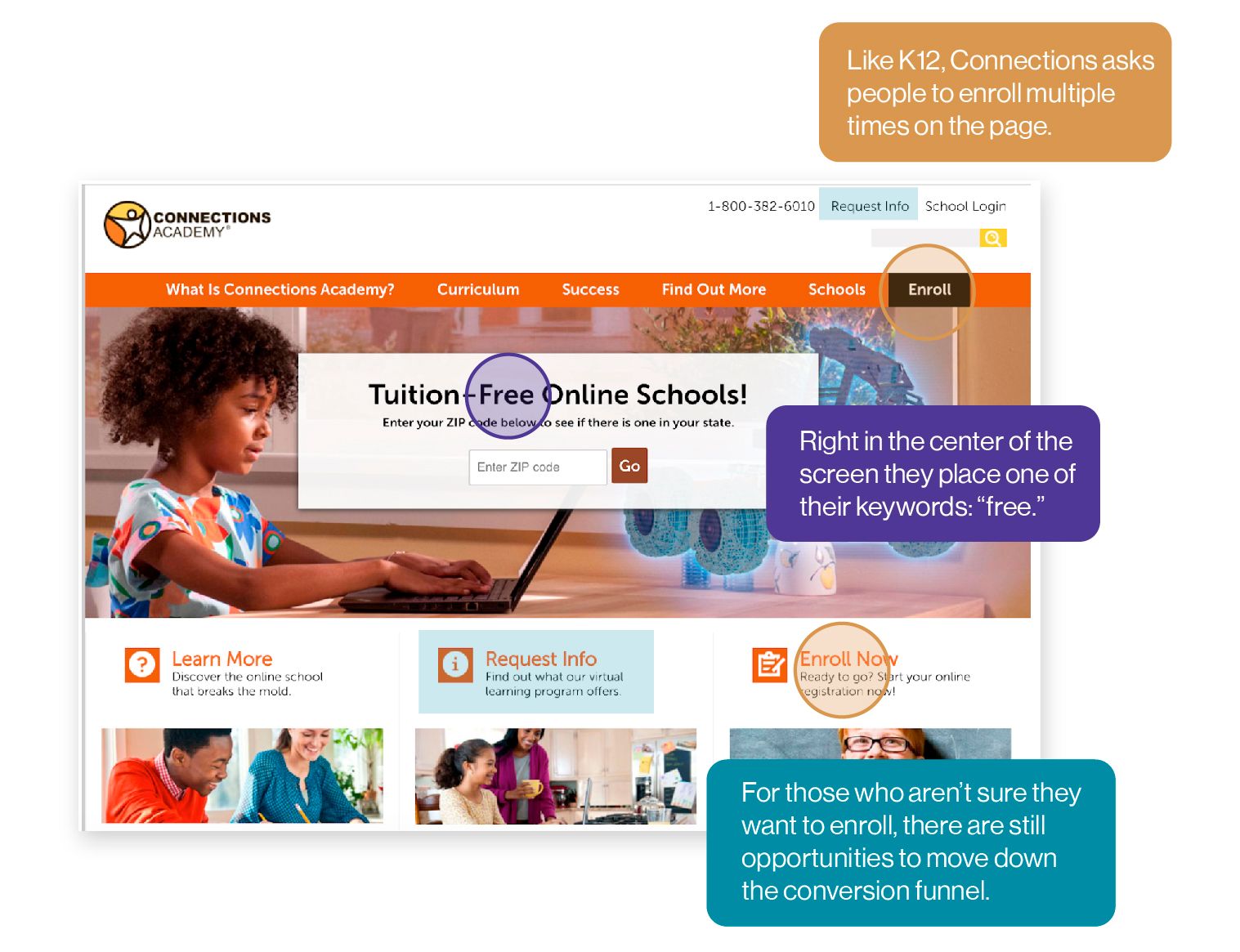
K12 and Connections offer a number of opportunities throughout their platforms for people to enroll. To get a feel of what the enrollment experience is like for families, our research team reached out to both organizations, filling out “contact us” forms on each website. Within 20 minutes, we got a call back, and those calls continued over the next few days. Connections mailed us a 49-page booklet within a week.
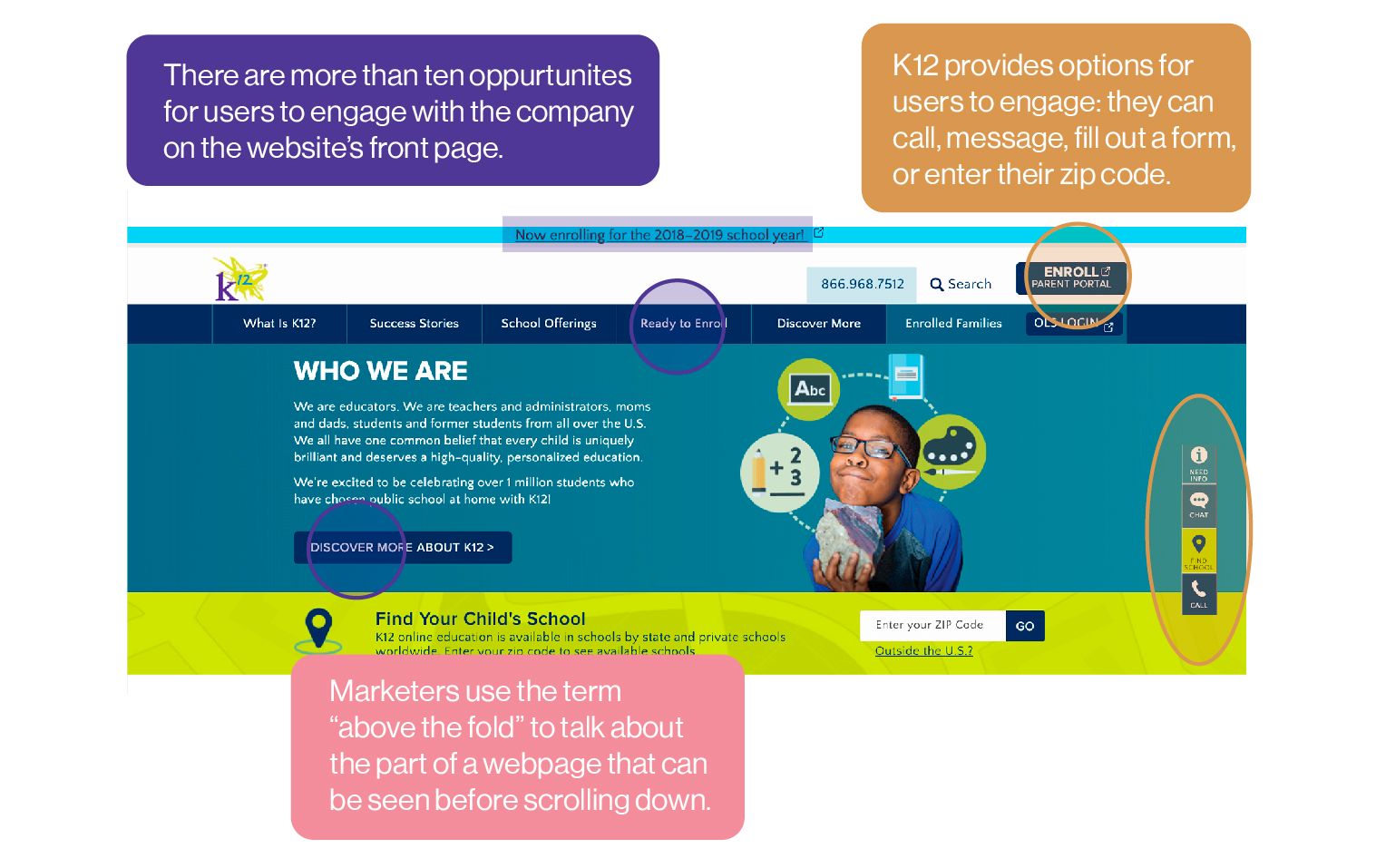
On the front page of K12’s website, you’ll find at least ten opportunities to find more information about enrollment. In most cases, users are asked to fill out forms that supply K12 with their contact information. K12 can use this data to send targeted advertisements to an interested base of customers, or to reach out to them in the future.
In order to usher visitors through the conversion funnel, marketers build easy-to-navigate processes. Asking customers to fill out a long form could turn people away, so K12 spreads questions across multiple pages, improving the customer’s overall experience.
In every correspondence we received from these companies, they always asked us to either fill out a form or call them. Whether through an email, social media ad, or print mailer, the call-to-action was the same. These messages came in like a flood. Knowing that most people will forget about their services soon after leaving their websites, K12 and Connections use every available opportunity to get their message in front of interested, potential customers.
We also noticed a significant amount of advertising on our personal Facebook and Instagram accounts after reaching out to K12 and Connections. This means that they are using software to target people who visited their sites, just like Amazon shows you ads about products you recently viewed.
The big takeaway here is that cyber schools’ sophisticated digital marketing teams carefully construct an experience that will get a maximum number of families to set up a phone call. From there, they can continue sending them materials, answering their objections, and nudging them to enroll.
Takeaways
Both K12 and Connections make it simple for families to complete their target action—enrolling in one of their schools. No matter what schools hope to accomplish in their marketing campaigns, they should make it easy for their audience to complete the final action, whether it's attending an event or enrolling in school.
- Repeatedly provide opportunities for your audience to enroll, subscribe, or otherwise engage.
- Give them all of the information they need to do so.
- Optimize websites, social media pages, and district communication for engagement.
Subscribe below to stay connected with SchoolCEO!


